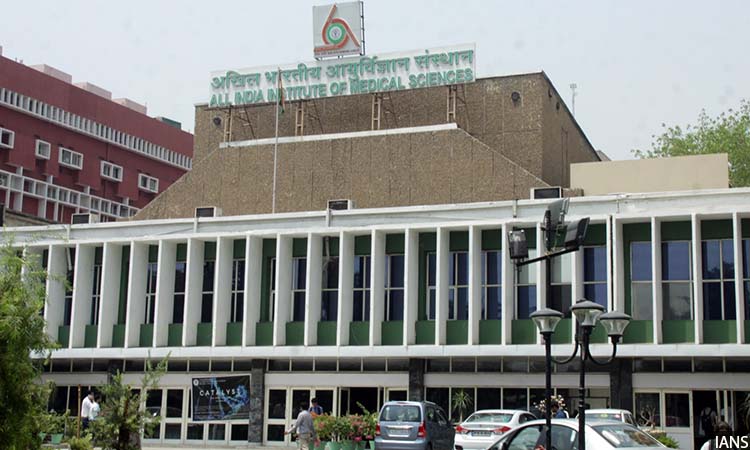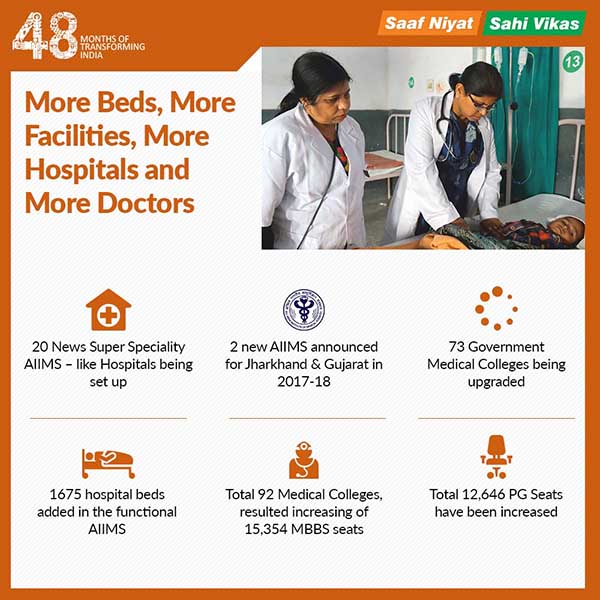20 New AIIMs Coming Up: BJP. Fact: 11 Get 3% Funding
 "text-align: justify;">New Delhi: On completing four years in the government, the ruling Bharatiya Janata Party (BJP), released a slew of infographics showcasing its campaigns for “transforming India”. One of the claims it made was the establishment of two new All India Institutes of Medical Sciences (AIIMS) in Jharkhand and Gujarat in 2017-18 and the setting up of 20 new “AIIMS-like” hospitals.
"text-align: justify;">New Delhi: On completing four years in the government, the ruling Bharatiya Janata Party (BJP), released a slew of infographics showcasing its campaigns for “transforming India”. One of the claims it made was the establishment of two new All India Institutes of Medical Sciences (AIIMS) in Jharkhand and Gujarat in 2017-18 and the setting up of 20 new “AIIMS-like” hospitals. 
Source: Bharatiya Janata Party
When the BJP-led National Democratic Alliance (NDA) government came to power in 2014, it announced four new AIIMS, seven more in 2015 and then two more in 2017.
Of these, none are near completion.
Other than the first-ever institute in New Delhi, set up in 1956, the only other working AIIMS in India are the six started during the previous NDA regime of then Prime Minister Atal Bihari Vajpayee and completed during the United Progressive Alliance (UPA) regime.
Another AIIMS, in Raebareli, Uttar Pradesh was announced in 2008 by the UPA government, and received cabinet approval in 2009. This is now estimated to be functional in March 2020.
Work on most of the 13 new institutes announced by the Modi government has been moving slowly. Five are yet to receive cabinet approval.
Only 3% of sanctioned funds for 11 new AIIMS have been released, according to a FactChecker analysis.
Up to 60% of faculty positions at the six working AIIMS are also vacant, according to a reply given by JP Nadda, the minister for health and family welfare, to a Lok Sabha question in February 2018.
We sent emails seeking comment to the minister for health, JP Nadda, on June 1, 2018, to the joint secretary, Pradhan Mantri Swasthya Suraksha Yojana (PMSSY)--the programme under which the new AIIMS are built--on May 30, 2018, and to the director, AIIMS Bhubaneswar, on June 1, 2018. There were no replies. We will update this story if and when they respond.
Why India needs more AIIMS
The first six new AIIMS at Bhopal, Bhubaneswar, Jodhpur, Patna, Raipur and Rishikesh were proposed under the first phase of the PMSSY, a health programme of the Vajpayee government in 2003.
The scheme’s objective was to correct regional imbalances in the availability of affordable and reliable tertiary healthcare services and boost quality medical education.
The programme included setting up of new AIIMS-like institutions and upgradation of existing government medical colleges.
It took three years for the approvals to arrive by which time the UPA was in power. The six new AIIMS were completed in 2012, but did not start working till 2014.
At 6 institutes, more than 60% posts vacant
All the six AIIMS started under the first NDA government are now working: The medical colleges are running and hospital blocks are around 90% completed. All of them have blood banks, emergency, trauma and diagnostic centres. There are 2,744 beds available between them, and 65 of 96 super-specialty departments and 107 of 108 specialty departments are functional.
However, 60% of the faculty positions and 81% of non-faculty posts are vacant, as per the Lok Sabha reply mentioned earlier.
As many as 1,300 posts were advertised for AIIMS at Bhopal, Bhubaneswar, Jodhpur, Patna, Raipur and Rishikesh last year. Only 300 were selected and 200 joined, the Indian Express reported on July 5, 2017.
“While substantially higher salary structures in the private sector for specialities such as nuclear medicine and neurosurgery is one factor, making recruitment for senior posts like professor and additional professor extremely difficult, the other factor is the lack of facilities in smaller centres where AIIMS have come up,” the Indian Express reported.
| Vacancies At Six Functional AIIMS | ||||||
|---|---|---|---|---|---|---|
| Location | FACULTY POSTS | NON-FACULTY POSTS | ||||
| Sanctioned Posts | Posts vacant at present | % vacancy | Sanctioned Posts | Posts vacant at | % vacancy | |
| Bhubaneswar | 305 | 147 | 48.2 | 3776 | 2983 | 79 |
| Jodhpur | 305 | 167 | 54.75 | 3776 | 3173 | 84.03 |
| Patna | 305 | 253 | 82.95 | 3776 | 2811 | 74.44 |
| Raipur | 305 | 207 | 67.87 | 3776 | 2790 | 73.89 |
| Rishikesh | 305 | 162 | 53.11 | 3776 | 3581 | 94.84 |
| Total | 1,830 | 1,106 | 60.44 | 22,656 | 18,454 | 81.45 |
Source: Lok Sabha
In the 2014-15 budget speech, plans for four new AIIMS were announced--in Mangalagiri in Andhra Pradesh, Nagpur in Maharashtra, Gorakhpur in Uttar Pradesh and Kalyani in West Bengal.
Plans for seven new AIIMS were announced in 2015-16 budget speech and they were to come up in Assam, Himachal Pradesh, Punjab, Tamil Nadu, Bihar and two in Jammu and Kashmir. In 2017-18 budget speech, the government announced two new AIIMS, one each in Gujarat and Jharkhand.
Also, of the 11 new AIIMS proposed in phases 2 and 4, with a budget of Rs 14,810 crore, only 2.7% or Rs 405.18 crore was released till 2017, according to a FactChecker analysis.
No funds have been released for the AIIMS at Rae Bareli in Uttar Pradesh in 2016-17 or 2017-18. It got cabinet approval in 2009 but its revised estimates were approved in 2017.
Under the scheme, the cost of setting up and running expenditure is borne by the union government and no funds for the new AIIMS are provided to the state government.
| New AIIMS Status, Funds Released & Expected Date Of Completion | ||||
|---|---|---|---|---|
| Proposed | Status | % of approved outlay released | Expected date for completion of project | |
| 2003 | Bhopal, Madhya Pradesh | Functional | - | Completed |
| Bhubaneshwar, Odisha | Functional | - | Completed | |
| Jodhpur, Rajasthan | Functional | - | Completed | |
| Patna, Bihar | Functional | - | Completed | |
| Raipur, Chhattisgarh | Functional | - | Completed | |
| Rishikesh, Uttarakhand | Functional | - | Completed | |
| 2008 | Raebareli, Uttar Pradesh | Approved | 12.6 | March, 2020 |
| 2014-15 | Nagpur, Maharashtra | Approved | 3.4 | Feb, 2020 |
| Gorakhpur, Uttar Pradesh | Approved | 0.9 | March, 2020 | |
| Kalyani, West Bengal | Approved | 3.3 | Feb,2020 | |
| Mangalagiri, Andhra Pradesh | Approved | 3.3 | Feb,2020 | |
| 2015-16 | Guwahati, Assam | Approved | 0.4 | April, 2021 |
| Bihar (yet to be decided) | Cabinet yet to approve | NA | Dec, 2022 | |
| Bilaspur, Himachal Pradesh | Approved | 0 | Sept, 2021 | |
| Awantipora, Jammu & Kashmir | Cabinet yet to approve | 2.3 | 2024 (tentative) | |
| Samba, Jammu & Kashmir | Cabinet yet to approve | 0 | 2022 (tentative) | |
| Bathinda, Punjab | Approved | 1.6 | April, 2020 | |
| Tamil Nadu (yet to be decided) | Cabinet yet to approve | NA | Sept, 2022 | |
| 2017-18 | Gujarat (yet to be decided) | Cabinet yet to approve | 0 | Sept, 2022 |
| Deogarh, Jharkhand | Approved | 0 | Sept, 2022 | |
Why the emphasis on tertiary institutes may not be effective
There has been a steady rise in PMSSY funds since 2012, an average of 31.9%. Also, it has increased 20% in 2018-19, accounting for 7% of India’s health budget.
But there has been a 2% decrease in allocations to the National Health Mission, which runs primary healthcare services. This decrease, along with the February 1, 2018, announcement of Ayushman Bharat, the National Health Protection Mission, which provides insurance cover of Rs 500,000 to 100 million families, shows the growing focus on tertiary care.
“The focus on prevention and early management of health problems can reduce the need for complicated specialist care provided at the tertiary level,” an expert group report for Universal Health Coverage For India recommended in 2011, adding that the government must focus on primary health care.
We welcome feedback. Please write to respond@indiaspend.org. We reserve the right to edit responses for language and grammar.
__________________________________________________________________ "text-align: justify;">“Liked this story? Indiaspend.org is a non-profit, and we depend on readers like you to drive our public-interest journalism efforts. Donate Rs 500; Rs 1,000, Rs 2,000.”


